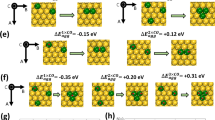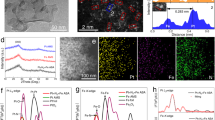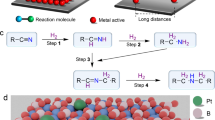Abstract
Brønsted acid sites on the oxide overlayers of metal–metal oxide inverse catalysts are often hypothesized to drive selective C–O bond activation. However, the Brønsted acid site nature and dynamics under working conditions remain poorly understood due to the functionalities of the constituent materials. Here we investigate the formation and the dynamics of Brønsted acid and redox sites on PtWOx/C under working conditions. Density functional theory-based thermodynamic calculations and microkinetic modelling reveal a complex interplay between Brønsted acid and redox sites and potentially fast catalyst dynamics at comparable timescales to the Brønsted acid catalysed dehydration chemistry. Combining in situ characterization and probe chemistry, we demonstrate that the density of Brønsted acid sites on the PtWOx/C inverse catalyst could be modulated by up to two orders of magnitude by altering the reaction parameters and by the chemistry itself. We elicit an order of magnitude increase in the acid-catalysed dehydration average reaction rate by periodic hydrogen pulsing.

This is a preview of subscription content, access via your institution
Access options
Access Nature and 54 other Nature Portfolio journals
Get Nature+, our best-value online-access subscription
$29.99 / 30 days
cancel any time
Subscribe to this journal
Receive 12 digital issues and online access to articles
$119.00 per year
only $9.92 per issue
Buy this article
- Purchase on Springer Link
- Instant access to full article PDF
Prices may be subject to local taxes which are calculated during checkout







Similar content being viewed by others
Data availability
The data to support the findings of this study are provided in the Supplementary Information and paper or from the corresponding author upon request. The atomic coordinates of the DFT-optimized WxOy/Pt(111) models and data that support the plots in this paper are available on Mendeley Data41.
Code availability
The code to convert ab initio data to microkinetic model inputs is available on Mendeley Data41. No specialized, home written software was used for this work.
References
Védrine, J. C. Heterogeneous catalysis on metal oxides. Catalysts 7, 341 (2017).
Tomishige, K., Nakagawa, Y. & Tamura, M. Selective hydrogenolysis and hydrogenation using metal catalysts directly modified with metal oxide species. Green Chem. 19, 2876–2924 (2017).
Chia, M. et al. Selective hydrogenolysis of polyols and cyclic ethers over bifunctional surface sites on rhodium–rhenium catalysts. J. Am. Chem. Soc. 133, 12675–12689 (2011).
Daniel, O. M. et al. X-ray absorption spectroscopy of bimetallic Pt–Re catalysts for hydrogenolysis of glycerol to propanediols. ChemCatChem 2, 1107–1114 (2010).
Wang, C. et al. Mechanistic study of the direct hydrodeoxygenation of m-cresol over WOx-decorated Pt/C catalysts. ACS Catal. 8, 7749–7759 (2018).
Wang, C. et al. A study of tetrahydrofurfuryl alcohol to 1,5-pentanediol over Pt–WOx/C. Catal. Letters 148, 1047–1054 (2018).
Yang, F. et al. Enhancement of m-cresol hydrodeoxygenation selectivity on Ni catalysts by surface decoration of MoOx species. ACS Catal. 9, 7791–7800 (2019).
Zhou, W. et al. Insight into the nature of Brönsted acidity of Pt-(WOx)n-H model catalysts in glycerol hydrogenolysis. J. Catal. 388, 154–163 (2020).
Stephens, K. J. et al. A mechanistic study of polyol hydrodeoxygenation over a bifunctional Pt-WOx/TiO2 catalyst. ACS Catal. 10, 12996–13007 (2020).
Lei, N. et al. Effective hydrogenolysis of glycerol to 1,3-propanediol over metal-acid concerted Pt/WOx/Al2O3 catalysts. ChemCatChem 11, 3903–3912 (2019).
Fu, J. et al. C–O bond activation using ultra-low loading noble metal catalysts on moderately reducible oxides. Nat. Catal. 3, 446–453 (2020).
Luo, J. et al. Mechanisms for high selectivity in the hydrodeoxygenation of 5-hydroxymethylfurfural over PtCo nanocrystals. ACS Catal. 6, 4095–4104 (2016).
Falcone, D. D. et al. Evidence for the bifunctional nature of Pt–Re catalysts for selective glycerol hydrogenolysis. ACS Catal. 5, 5679–5695 (2015).
Rasmussen, M. J. & Medlin, J. W. Role of tungsten modifiers in bimetallic catalysts for enhanced hydrodeoxygenation activity and selectivity. Catal. Sci. Technol. 10, 414–423 (2020).
Murugappan, K. et al. Operando NAP-XPS unveils differences in MoO3 and Mo2C during hydrodeoxygenation. Nat. Catal. 1, 960–967 (2018).
Deo, S., Medlin, W., Nikolla, E. & Janik, M. J. Reaction paths for hydrodeoxygenation of furfuryl alcohol at TiO2/Pd interfaces. J. Catal. 377, 28–40 (2019).
Li, Z. et al. Growth of ordered ultrathin tungsten oxide films on Pt(111). J. Phys. Chem. C. 115, 5773–5783 (2011).
Horsley, J. A., Wachs, I. E., Brown, J. M., Via, G. H. & Hardcastle, F. D. Structure of surface tungsten oxide species in the WO3/Al2O3 supported oxide system from X-ray absorption near-edge spectroscopy and Raman spectroscopy. J. Phys. Chem. 91, 4014–4020 (1987).
Yamazoe, S., Hitomi, Y., Shishido, T. & Tanaka, T. XAFS study of tungsten L1- and L3-edges: structural analysis of WO3 species loaded on TiO2 as a catalyst for photo-oxidation of NH3. J. Phys. Chem. C. 112, 6869–6879 (2008).
Baertsch, C. D., Soled, S. L. & Iglesia, E. Isotopic and chemical titration of acid sites in tungsten oxide domains supported on zirconia. J. Phys. Chem. B 105, 1320–1330 (2001).
He, J. et al. Synthesis of 1,6-hexanediol from cellulose derived tetrahydrofuran-dimethanol with Pt-WOx/TiO2 catalysts. ACS Catal. 8, 1427–1439 (2018).
Iglesia, E. et al. Selective isomerization of alkanes on supported tungsten oxide acids. Stud. Surf. Sci. Catal. 101, 533–543 (1996).
Fouad, N. E., Attyia, K. M. E. & Zaki, M. I. Thermogravimetry of WO3 reduction in hydrogen: kinetic characterization of autocatalytic effects. Powder Technol. 74, 31–37 (1993).
Alexopoulos, K., Wang, Y. & Vlachos, D. G. First-principles kinetic and spectroscopic insights into single-atom catalysis. ACS Catal. 9, 5002–5010 (2019).
Regalbuto, J. R., Fleisch, T. H. & Wolf, E. E. An integrated study of Pt/WO3/SiO2 catalysts for the NO–CO reaction: i. catalyst characterization by XRD, chemisorption, and XPS. J. Catal. 107, 114–128 (1987).
Kammert, J. D., Brezicki, G., Miyake, N., Stavitski, E. & Davis, R. J. Reduction of propanoic acid over Pd-promoted supported WOx catalysts. ChemCatChem 12, 314–325 (2020).
Abdelrahman, O. A. et al. Simple quantification of zeolite acid site density by reactive gas chromatography. Catal. Sci. Technol. 7, 3831–3841 (2017).
Bernholc, J., Horsley, J. A., Murrell, L. L., Sherman, L. G. & Soled, S. Brønsted acid sites in transition metal oxide catalysts: modeling of structure, acid strengths, and support effects. J. Phys. Chem. 91, 1526–1530 (1987).
Liu, L. et al. Selective hydrogenolysis of glycerol to 1,3-propanediol over rhenium-oxide-modified iridium nanoparticles coating rutile titania support. ACS Catal. 9, 10913–10930 (2019).
Liu, S., Amada, Y., Tamura, M., Nakagawa, Y. & Tomishige, K. One-pot selective conversion of furfural into 1,5-pentanediol over a Pd-added Ir-ReOx/SiO2 bifunctional catalyst. Green Chem. 16, 617–626 (2014).
Shi, D. et al. WOx supported on ɣ-Al2O3 with different morphologies as model catalysts for alkanol dehydration. J. Catal. 363, 1–8 (2018).
Kresse, G. & Furthmüller, J. Efficient iterative schemes for ab initio total-energy calculations using a plane-wave basis set. Phys. Rev. B 54, 11169–11186 (1996).
Perdew, J. P., Burke, K. & Ernzerhof, M. Generalized gradient approximation made simple. Phys. Rev. Lett. 77, 3865–3868 (1996).
Pack, J. D. & Monkhorst, H. J. “Special points for Brillouin-zone integrations”—a reply. Phys. Rev. B 16, 1748–1749 (1977).
Henkelman, G., Uberuaga, B. P. & Jónsson, H. A climbing image nudged elastic band method for finding saddle points and minimum energy paths. J. Chem. Phys. 113, 9901–9904 (2000).
Lym, J., Wittreich, G. R. & Vlachos, D. G. A python multiscale thermochemistry toolbox (pMuTT) for thermochemical and kinetic parameter estimation. Comput. Phys. Commun. 247, 106864 (2020).
Joly, Y. X-ray absorption near-edge structure calculations beyond the muffin-tin approximation. Phys. Rev. B 63, 125120 (2001).
Bunǎu, O. & Joly, Y. Self-consistent aspects of X-ray absorption calculations. J. Phys. Condens. Matter 21, 345501 (2009).
Onn, T. M. et al. Smart Pd catalyst with improved thermal stability supported on high-surface-area LaFeO3 prepared by atomic layer deposition. J. Am. Chem. Soc. 140, 4841–4848 (2018).
Ravel, B. & Newville, M. ATHENA, ARTEMIS, HEPHAESTUS: data analysis for X-ray absorption spectroscopy using IFEFFIT. J. Synchrotron Radiat. 12, 537–541 (2005).
Fu, J. et al. Dataset for modulating the dynamics of Brønsted acid sites on PtWOx inverse catalyst. Mendeley Data https://doi.org/10.17632/hp45n9ykd6.1 (2021).
Acknowledgements
This work was financially supported primarily by the Catalysis Center for Energy Innovation, an Energy Frontier Research Center funded by the US Department of Energy, Office of Science, Office of Basic Energy Sciences under award number DESC0001004. Portions of this work were performed at the DuPont–Northwestern–Dow Collaborative Access Team (DND-CAT) located at Sector 5 of the Advanced Photon Source. DND-CAT is supported by Northwestern University, E.I. DuPont de Nemours and Co. and The Dow Chemical Company. This research used resources of the Advanced Photon Source, a US Department of Energy, Office of Science user facility operated for the Department of Energy, Office of Science by Argonne National Laboratory under contract no. DE-AC02-06CH11357. The research was carried out in part at the 7-BM (QAS) beamline of the National Synchrotron Light Source II at Brookhaven National Laboratory, which is supported by the Synchrotron Catalysis Consortium, US Department of Energy under grant no. DE-SC0012335 and at the Center for Functional Nanomaterials, Brookhaven National Laboratory, which is supported by the US Department of Energy, Office of Basic Energy Sciences under contract no. DE-SC0012704. Some of the XPS measurements were carried out using the Thermo Scientific K-Alpha+ XPS System at the University of Delaware surface analysis facility supported by NSF (no. 1428149). Y.L. acknowledges financial support from the Chinese Academy of Science Youth Innovation Promotion Association (no. 2018220) and LiaoNing Revitalization Talents Program (no. XLYC1907053), and X.L. acknowledges financial support from the National Natural Science Foundation of China (nos. 21872163, 22072090, 21991153 and 21991150) for the annular dark-field (ADF)-STEM analysis. The authors acknowledge H. Matsumoto for assistance with STEM data acquisition from a Hitachi HF5000 microscope. We acknowledge W. Wu for assisting with the XPS measurements, Q. Ma, S. Ehrlich, N. S. Marinkovic and L. Ma for helping with the XAS measurements and S. Prodinger for valuable discussions.
Author information
Authors and Affiliations
Contributions
J.F. performed experimental kinetics, XAS and XPS analyses. S.L. carried out the DFT calculations, the XANES simulation and the microkinetic modelling. W.Z. performed XPS and XAS studies. R.H. and C.W. synthesized the catalysts. A.L. conducted reactive gas chromatography. K.A. provided guidance for XANES simulation. K.A. and S.L. assisted with XAS measurements. S.L., Y.W. and J.A.B. conducted the XPS measurements. K.Y. performed the TPR measurements. Y.L. and X.L. carried out the ADF-STEM analysis. A.I.F. provided guidance for the XAS data analysis. O.A.A. provided guidance for the acid site density measurements. R.J.G. provided insights into the experimental work. S.C. guided the DFT calculations. D.G.V. directed the project and provided guidance for the experimental and theoretical work. The manuscript was written by J.F., S.L. and D.G.V. with input from all authors.
Corresponding author
Ethics declarations
Competing interests
The authors declare no competing interests.
Peer review
Peer review information
Nature Catalysis thanks Gianfranco Pacchioni and the other, anonymous, reviewer(s) for their contribution to the peer review of this work.
Additional information
Publisher’s note Springer Nature remains neutral with regard to jurisdictional claims in published maps and institutional affiliations.
Supplementary information
Supplementary Information
Supplementary Methods, Figs. 1–25, Tables 1–4 and Notes 1 and 2.
Rights and permissions
About this article
Cite this article
Fu, J., Liu, S., Zheng, W. et al. Modulating the dynamics of Brønsted acid sites on PtWOx inverse catalyst. Nat Catal 5, 144–153 (2022). https://doi.org/10.1038/s41929-022-00745-y
Received:
Accepted:
Published:
Issue Date:
DOI: https://doi.org/10.1038/s41929-022-00745-y
This article is cited by
-
Metallic W/WO2 solid-acid catalyst boosts hydrogen evolution reaction in alkaline electrolyte
Nature Communications (2023)
-
Tailoring a local acid-like microenvironment for efficient neutral hydrogen evolution
Nature Communications (2023)
-
Tuning the reactivity of carbon surfaces with oxygen-containing functional groups
Nature Communications (2023)
-
Advanced Kinetic and Titration Strategies for Assessing the Intrinsic Kinetics on Oxide and Sulfide Catalysts
Topics in Catalysis (2023)
-
PtNi-W/C with Atomically Dispersed Tungsten Sites Toward Boosted ORR in Proton Exchange Membrane Fuel Cell Devices
Nano-Micro Letters (2023)



